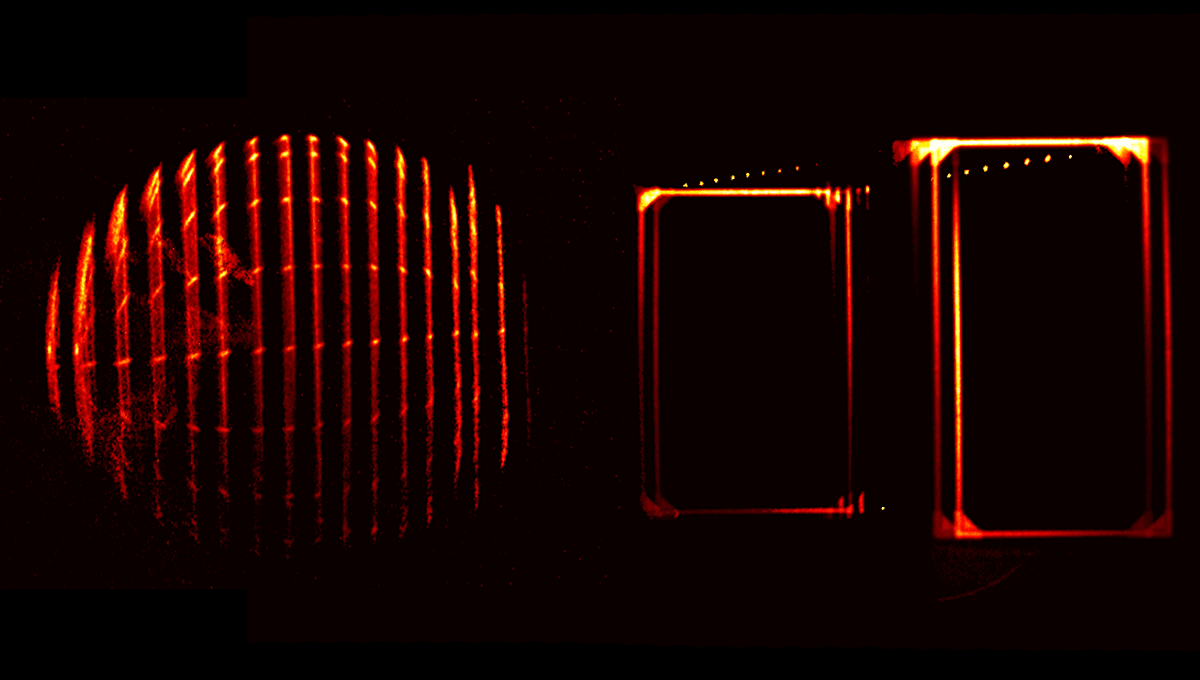
An experiment has visualized a prediction about objects traveling at the speed of light known as the Penrose-Terrell Effect, first made over 60 years ago.
When objects approach the speed of light (let’s call it a spaceship, for ease) a number of strange things take place. According to our best classical model of the universe, an observer looking at the spaceship passing by will see the length of the spaceship as shorter.
“Suppose a rocket whizzes past us at ninety per cent of the speed of light,” Professor Peter Schattschneider from TU Wien explained in a statement. “For us, it no longer has the same length as before it took off, but is 2.3 times shorter.”
Meanwhile, the spaceship will perceive its own length to be normal, and see it as you who has been contracted in length.
This, like time dilation, is an accepted part of Einstein’s theory of special relativity. But other effects have been predicted too, including an apparent rotation of objects passing each other at relativistic speeds. One prediction, made by James Terrell and Roger Penrose in 1959, is that objects other than a sphere (with its enviable rotational symmetry) will appear rotated to another observer.
“It is shown that, if the apparent directions of objects are plotted as points on a sphere surrounding the observer, the Lorentz transformation corresponds to a conformal transformation on the surface of this sphere. Thus, for sufficiently small subtended solid angle, an object will appear—optically—the same shape to all observers. A sphere will photograph with precisely the same circular outline whether stationary or in motion with respect to the camera,” Terrell explained in one 1959 paper on the topic. “An object of less symmetry than a sphere, such as a meter stick, will appear, when in rapid motion with respect to an observer, to have undergone rotation, not contraction.”
According to the works, this contraction and rotation cannot be photographed of a sphere.
“If you wanted to take a picture of the rocket as it flew past, you would have to take into account that the light from different points took different lengths of time to reach the camera,” explained Schattschneider.
“This result may seem paradoxical at first. For example, it might be thought that for a distant sphere moving perpendicularly to the line joining its centre to the observer, the flattening in its direction of motion would certainly be apparent, Penrose and Terrell explained in another 1959 paper.
“As the tangents from the observer to the flattened sphere are all nearly the same length, it might seem that the finite velocity of light is irrelevant here. However, the light which appears to the observer to be coming from the leading part of the sphere leaves the sphere at a later time, in the observer’s frame, than that which appears to come from the trailing part. In fact the light from the trailing part reaches the observer from behind the sphere, which it can do since the sphere is continually moving out of its way. The length of the image of the sphere in the direction of motion is thus greater than might otherwise be expected, so that if it were not for the flattening the sphere would appear to be elongated.”
While spheres would look spherical, they would appear to have a different pole, as if it had been rotated. The effect can be more easily explained with a cube, and it is with a cube that the new team attempted to visualize the phenomenon, with the aid of extremely short laser pulses and a high-speed camera.
“We moved a cube and a sphere around the lab and used the high-speed camera to record the laser flashes reflected from different points on these objects at different times,” said Victoria Helm and Dominik Hornof, the two students who carried out the experiment. “If you get the timing right, you can create a situation that produces the same results as if the speed of light were no more than 2 metres per second [4.5 miles per hour].”
Imagine a hollow cube structure moving at absurd speed, or a slow version of that cube emitting incredibly slow waves of light. If two photons of light hit your eyes at the same time – one from the front of the cube, and one from the back of the cube – that means they were emitted at slightly different times, with the photon from the back of the cube being emitted first.
“This makes it look to us as if the cube had been rotated,” Schattschneider added.
“A train of laser pulses is sent toward an object, and the reflected light is captured using a gated camera,” the team elaborates in their paper. “The delay Δt between the laser pulses and the exposure is scanned, effectively revealing the motion of pulsed light across the static object. The trick to visualizing relativistic motion is to displace the object by the distance it would move during the delay time Δt.”
Using the setup, the team produced the visualization of what we would see were the cube moving at 80 percent the speed of light, and a sphere at 99.9 percent the speed of light.
“We combined the still images into short video clips of the ultra-fast objects. The result was exactly what we expected,” said Schattschneider. “A cube appears twisted, a sphere remains a sphere, but the North Pole is in a different place.”
The study is published in Communications Physics.
Source Link: Experiment Appears To Confirm Mind-Bending Penrose-Terrell Effect Predicted 66 Years Ago